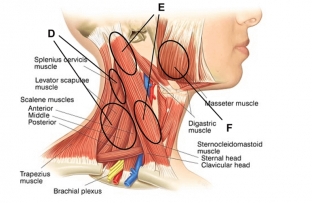Already after the birth of a child, some congenital pathologies that can and should be eliminated are detected during examination. So, torticollis in a child, when examined by an experienced specialist, is diagnosed from the first days of life, which makes it possible to help the child get rid of this problem. To do this, it is necessary not only to notice the torticollis in a child, but also to distinguish it from other pathologies, and also to prescribe procedures for the proper functioning of the muscles. How to identify torticollis in a child and when should it be treated?
What are the causes of torticollis in a child?
Torticollis is a condition that develops in newborns due to dysplasia of the sternocleidomastoid muscle. Dysplasia of this muscle can develop for several reasons, which are associated both with the course of pregnancy and with the course of the birth itself. Torticollis often develops when there is a forced position of the baby in the uterus during pregnancy due to entanglement with the umbilical cord. Also, torticollis in a child can be triggered by trauma to the child during childbirth. Dysplasia m. sternocleidomasteideus can provoke the development of an inflammatory or dystrophic process in it.
Signs of torticollis in a child. How to detect torticollis in the early stages?
Identification of such a developmental pathology as torticollis in a child requires early diagnosis, when it is still possible to correct the work of the muscles. Indeed, after the first year of life, it is possible to cure torticollis in a child only by surgery. Why is that? The fact is that in the second year of life, when the muscles of the face and neck are already slightly developed and formed, untreated torticollis leads to asymmetry of the face and skull on the side of the head tilt. And then physical exercises and other methods of treatment are no longer effective. Therefore, it is important to identify torticollis in a child as early as possible.
The main signs of torticollis in a child:
- baby's head is constantly tilted to one side;
- chin is turned in the opposite direction from the tilt;
- attempt to put the head in the correct straight position is unsuccessful due to tension in the muscles of the neck;
- at the level of the middle third m. sternocleidomasteideus, a spindle-like thickening is found, which is not soldered to the surrounding tissues;
- forearm and scapula of the child are higher on the side of the lesion;
- palpable spinous process C2;
- Child's neck appears short on affected side due to contracture of trapezius and scalene muscles;
- In older children, scoliosis of the spine and asymmetry of half of the face and skull are found.

What diseases should be differentiated from torticollis in a child?
If torticollis is suspected in a child, a differential diagnosis should be made with diseases that are clinically similar to torticollis.
- Congenital additional wedge-shaped vertebra – while the head is tilted to the side, but the chin is not turned in the opposite direction, and an obstacle is felt when leveling the head.
- Spastic torticollis – occurs in children with cerebral palsy.
- Muscular torticollis due to poliomyelitis – there is paresis or paralysis m. sternocleidomasteideus and other muscles. With congenital torticollis in a child, the muscle is not paralyzed, neither are the limbs.
- Dermatogenic torticollis – develops after thermal or chemical burns or injuries, desmogenic torticollis – develops after the transfer of inflammatory processes in the neck (phlegmon, abscess).
- Inflammatory processes of the middle ear – torticollis is reflex in nature.
- Klippel Syndrome – File – this is a congenital defect of the cervical vertebrae, that is, the atlas and the second cervical vertebra are fused together. At the same time, a short neck is observed, the head seems to have grown together with the body, the border of the hair on the back of the shoulder blades, the child's head is tilted forward and to the side. The chin touches the chest, the asymmetry of the face and skull is pronounced at any age, the absence of movements in the cervical spine, kyphosis or scoliosis. All these symptoms are absent in congenital torticollis in a child.
- Pterygoid neck (Shereshevsky-Turner syndrome) – unilateral or bilateral pterygoid folds on the lateral surfaces of the neck. At the same time, the auricles are deformed, and the child's face looks like a sphinx.
- Grisel's disease – inflammation of the nasopharynx, which passes to the area of \u200b\u200bthe atlas, provoking its subluxation. There is a contracture of the paravertebral muscles.
Knowing the manifestations of these pathologies, you can quickly and correctly diagnose torticollis in a child.
What are the treatments for torticollis in a child?
If torticollis is detected in a child, its treatment is started immediately, but only with the condition of complete fusion of the umbilical ring. To do this, parents are advised to lay the child on the pillow with the diseased side so that it helps to tilt the head to the healthy side. Toys and anything the child pays attention to should be placed on the opposite side of the lesion.
Starting from 3-4 weeks of life, it is necessary to perform exercises aimed at working the affected muscle and deflecting the head to the healthy side. Such procedures should be done for 15 minutes several times a day, after each session, fix the neck with a Shants collar. Thus, early detection and proper treatment of torticollis in a child can prevent the consequences, and also help to avoid surgical intervention.








Add a comment